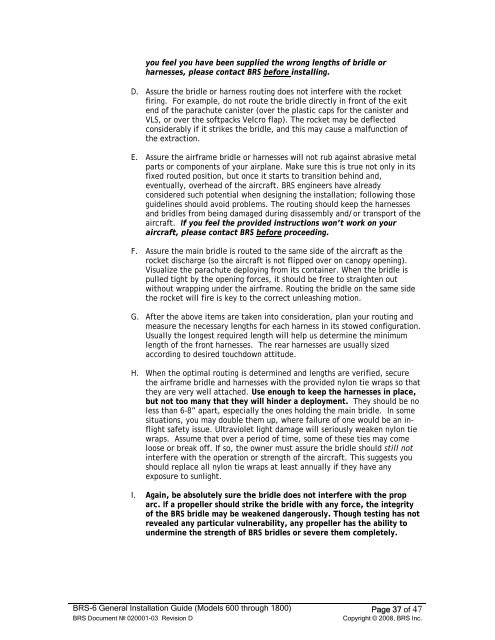BRS-6 General Installation Guide - CAFE Foundation
BRS-6 General Installation Guide - CAFE Foundation
BRS-6 General Installation Guide - CAFE Foundation
You also want an ePaper? Increase the reach of your titles
YUMPU automatically turns print PDFs into web optimized ePapers that Google loves.
you feel you have been supplied the wrong lengths of bridle or<br />
harnesses, please contact <strong>BRS</strong> before installing.<br />
D. Assure the bridle or harness routing does not interfere with the rocket<br />
firing. For example, do not route the bridle directly in front of the exit<br />
end of the parachute canister (over the plastic caps for the canister and<br />
VLS, or over the softpacks Velcro flap). The rocket may be deflected<br />
considerably if it strikes the bridle, and this may cause a malfunction of<br />
the extraction.<br />
E. Assure the airframe bridle or harnesses will not rub against abrasive metal<br />
parts or components of your airplane. Make sure this is true not only in its<br />
fixed routed position, but once it starts to transition behind and,<br />
eventually, overhead of the aircraft. <strong>BRS</strong> engineers have already<br />
considered such potential when designing the installation; following those<br />
guidelines should avoid problems. The routing should keep the harnesses<br />
and bridles from being damaged during disassembly and/or transport of the<br />
aircraft. If you feel the provided instructions won’t work on your<br />
aircraft, please contact <strong>BRS</strong> before proceeding.<br />
F. Assure the main bridle is routed to the same side of the aircraft as the<br />
rocket discharge (so the aircraft is not flipped over on canopy opening).<br />
Visualize the parachute deploying from its container. When the bridle is<br />
pulled tight by the opening forces, it should be free to straighten out<br />
without wrapping under the airframe. Routing the bridle on the same side<br />
the rocket will fire is key to the correct unleashing motion.<br />
G. After the above items are taken into consideration, plan your routing and<br />
measure the necessary lengths for each harness in its stowed configuration.<br />
Usually the longest required length will help us determine the minimum<br />
length of the front harnesses. The rear harnesses are usually sized<br />
according to desired touchdown attitude.<br />
H. When the optimal routing is determined and lengths are verified, secure<br />
the airframe bridle and harnesses with the provided nylon tie wraps so that<br />
they are very well attached. Use enough to keep the harnesses in place,<br />
but not too many that they will hinder a deployment. They should be no<br />
less than 6-8” apart, especially the ones holding the main bridle. In some<br />
situations, you may double them up, where failure of one would be an inflight<br />
safety issue. Ultraviolet light damage will seriously weaken nylon tie<br />
wraps. Assume that over a period of time, some of these ties may come<br />
loose or break off. If so, the owner must assure the bridle should still not<br />
interfere with the operation or strength of the aircraft. This suggests you<br />
should replace all nylon tie wraps at least annually if they have any<br />
exposure to sunlight.<br />
I. Again, be absolutely sure the bridle does not interfere with the prop<br />
arc. If a propeller should strike the bridle with any force, the integrity<br />
of the <strong>BRS</strong> bridle may be weakened dangerously. Though testing has not<br />
revealed any particular vulnerability, any propeller has the ability to<br />
undermine the strength of <strong>BRS</strong> bridles or severe them completely.<br />
<strong>BRS</strong>-6 <strong>General</strong> <strong>Installation</strong> <strong>Guide</strong> (Models 600 through 1800) Page 37 of 47<br />
<strong>BRS</strong> Document № 020001-03 Revision D Copyright © 2008, <strong>BRS</strong> Inc.

















